Lokd is a DJVU family of ransomware-type infections1. The infection encrypts important personal files (video, photos, documents). The encrypted files can be tracked by specific “.lokd” extension. So, you can’t obtain access to them at all.
In this tutorial I will try to help you remove Lokd virus without any payment. As a bonus, I will assist you in decoding your encrypted files.
What is “Lokd”?
Lokd can be correctly identify as a ransomware-type infection.
Ransomware is a specific kind of virus that encrypts your documents and then forces you to pay to restore them. DJVU (aka STOP) ransomware family was first revealed and analyzed by virus analyst Michael Gillespie2.Lokd is similar to other representatives of the same family: Rezm, Rezm, Nppp. It encrypts all popular file types. Hence, you cannot work with the your documents or photos, and all external drives you connected or connecting to infected PC will be encrypted, too. Lokd adds its particular “.lokd” extension into all files. For instance, the file “video.avi”, will be amended into “video.avi.lokd”. As soon as the encryption is accomplished, Lokd drops a special text file “_readme.txt” and puts it into all folders that contain the modified files.
Here is a info for the Lokd :
| Ransomware family3 | DJVU/STOP4 ransomware |
| Extension | .lokd |
| Ransomware note | _readme.txt |
| Ransom | From $490 to $980 (in Bitcoins) |
| Contact | datarestorehelp@firemail.cc, datahelp@iran.ir |
| Detection | Win64:TrojanX-gen [Trj], Win64/Packed.Themida.IL, Graftor.636898 |
| Symptoms | Your files (photos, videos, documents) have a .lokd extension and you can’t open it |
| Fix Tool | See If Your System Has Been Affected by .lokd file virus |
This text asking payment is for restore files via decryption key:
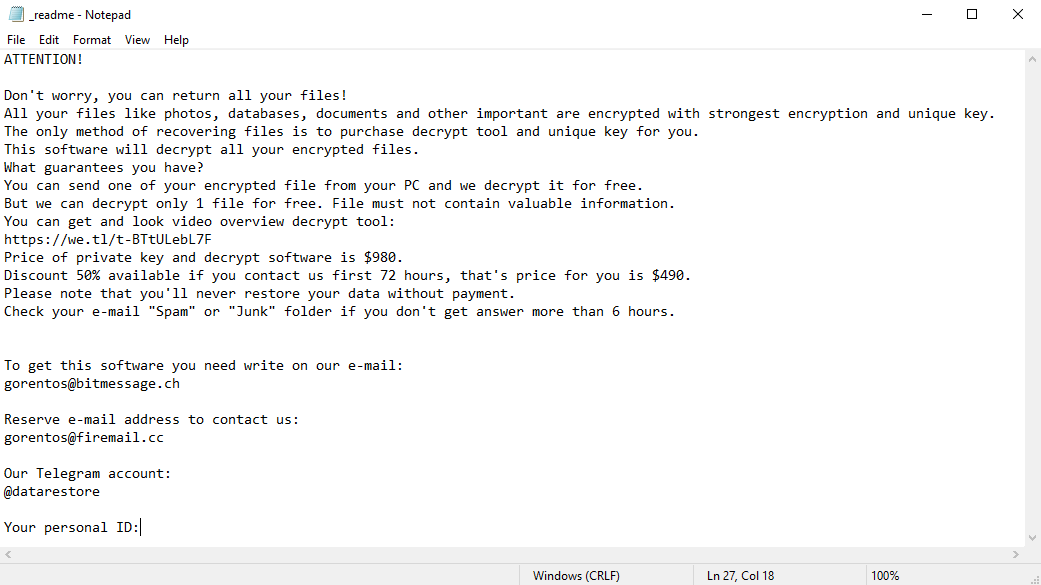
The scary alert demanding from users to pay the ransom to decrypt the compromised data contains these frustrating warnings
The cryptography algorithm used by Lokd is AES-256. So, if your documents got encrypted with a specific decryption key, which is totally unique and there are no other copies. The sad reality is that it is impossible to restore the information without the unique key available.
In case if Lokd worked in online mode, it is impossible for you to gain access to the AES-256 key. It is stored on a remote server owned by the criminals who promote the Lokd ransomware. It could be a solution to turn your Internet connection off and use a decryptor to get your files back, but as soon as you will be back online, the ransomware will get another command to encrypt your files.
For receiving decryption key the payment should be $980. To obtain the payment details the victims are encouraged by the message to contact the frauds by email (gorentos@bitmessage.ch), or via Telegram.
Do not pay for Lokd!
Please, try to use the available backups, or Decrypter tool
_readme.txt file also indicates that the computer owners must get in touch with the Lokd representatives during 72 hours starting from the moment of files where encrypted. On the condition of getting in touch within 72 hours, users will be granted a 50% rebate, thus the ransom amount will be minimized down to $490). Sometimes, distributors can start a chat with their victim, trying to force him/her to pay. Nonetheless, stay away from paying the ransom!
I strongly recommend you not to contact these crooks and not to pay them a penny. The one of the most real working solution to recover the lost data – just using the available backups, or use Decrypter tool in combination with Anti-Malware software.
The peculiarity of all such viruses apply a similar set of actions for generating the unique decryption key to recover the ciphered data. And only this frauds have an access to this key.
Thus, unless the ransomware is still under the stage of development or possesses with some hard-to-track flaws, manually recovering the ciphered data is a thing you can’t really perform. The only solution to prevent the loss of your valuable data is to regularly make backups of your crucial files.
Note that even if you do maintain such backups regularly, they ought to be put into a specific location without loitering, not being connected to your main workstation.
For instance, the backup may be kept on the USB flash drive or some alternative external hard drive storage. Optionally, you may refer to the help of online (cloud) information storage.
Needless to mention, when you maintain your backup data on your common device, it may be similarly ciphered as well as other data, so you will lost a chance to recover your data without external software interruption.
Another problem that could appear in process of system recovery via backup is a probability of ransomware precense in backup files. Ransomware can be asleep for a long time, so in some time user can find out that he was been attacked, again, and even without downloading anything. Even more, the ransomware can launch once user finished his backup, because “launch encrypting” command is already sent from fraudsters’ command server , and as soon as user’s PC getting online, ransomware will get “launch encrypting” command.
Also, some users, generally with weak PC, detected an unusuall activity on their machines via awful slowdown of their computers, that are already performing low. So, if you detected an unusuall lagspikes for your machine – wait for bad news and .lokd extensions on your files.
For this reason, locating the backup on your main device is surely not a wise idea.
How I was infected?
Lokd has a various methods to built into your system. But it doesn’t really matter what concrete method was used in your case.

Lokd ransomware attack following a successful phishing attempt.
- hidden installation along with other apps, especially the utilities that work as freeware or shareware;
- dubious link in spam emails leading to the Lokd installer
- online free hosting resources;
- using illegal peer-to-peer (P2P) resources for downloading pirated software.
There were cases when the Lokd virus was disguised as some legitimate tool, for example, in the messages demanding to initiate some unwanted software or browser updates. This is typically the way how some online frauds aim to force you into installing the Lokd ransomware manually, by actually making you directly participate in this process.
Lokd ransomware, like another ransomwares, is usually distributed in pack with different malware. First, user can notice something annoying and simple, like adware, or browser hijacker, that could be removed even manually. Also it could be keyloggers or trojans of some sort, but their activity is quite hard to track, so user wouldn’t notice their precence.
Pay a lot of attention to suspicious software, that is promising to be very effective and easy to use for free. Such software is usually used as a carrier for light types of malware e.g. browser hijackers, but this malware installing you can cancel in installation menu. Ransomware could be pushed in the same way, but it’s injection likely cannot be cancelled.
Surely, the bogus update alert will not indicate that you are going to actually inject the Lokd ransomware. This installation will be concealed under some alert mentioning that allegedly you should update Adobe Flash Player or some other dubious program whatsoever.
Assuming this paragraph, I gonna advice you to avoid all suspicious links and do not open attachments to messages from unknown e-mail adresses. Also, if you get any malware on your PC – it’s a reason to start a full scan in your anti-malware program, because there is a big chance of getting a ransomware in pack.
Of course, the cracked apps represent the damage too. Using P2P is both illegal and may result in the injection of serious malware, including the Lokd ransomware.
Another source of ransomware can be “free” software with “unique” functions, that could be produced and distributed by ransomware creators, or by their partners. One of the best examples – SAntivirus, that was recently been spotted in Remk ransomware distribution in pack with it PUP-antivirus.
To sum up, what can you do to avoid the injection of the Lokd ransomware into your device? Even though there is no 100% guarantee to prevent your PC from getting damaged, there are certain tips I want to give you to prevent the Lokd penetration. You must be cautious while installing free software today.
Make sure you always read what the installers offer in addition to the main free program. Stay away from opening dubious email attachments. Do not open files from the unknown addressees. Of course, your current security program must be always updated.
UPD 18.03.20. .lokd ransomware, few days after .nppp ransomware started an agressive distribution campaing via e-mail. A lot of users from Central Europe reported about e-mail spam-wave on gmail, yahoo and several corporate e-mail hostings. This e-mails containing an offer to start using a “complete new and innovative web browser, that have pre-installed add-ons and extreme low CPU and RAM consumption”. Tricksters are introducing themself like a young team of software developers. In an archieve, that fraudsters sending in this e-mail, there is something looking like a browser, and unexpirienced user can trust this first outlook, but ransomware is hidden deeply inside. After “installing” you will get the same symptoms – files with .lokd/.nppp extension and “readme.txt” in each folder with encrypted files. They’re likely using a botnet, because all users got an e-mails from different mailboxes, and a lot of users who get a .nppp “offer” got an offer from .lokd distributors, too.
UPD 20.03.2020 .lokd increased it’s “price-list”. Now fraudsters extorting from users 1500$ if they pay later than 72 hours, or the same 490$ if user pays in time. And, of course, they need your money only in Bitcoins. But don’t get your hopes up that ransomware distributors will be fair-playing, and send you a key after your payment.
UPD 25.03.2020. An interesting statistics been delivered : a lot of users who been attacked by .lokd ransomware in last month reported that they previously got a browser hijacker that chanced their search engine to yandex.com and was opening an annoying ad in separate window. So, if you got such symptoms, it’s a good reason to check your PC with an anti-malware software, and strictly using full scan – ransomware can hide anywhere.
The malware does not speak openly about itself. It will not be mentioned in the list of your available programs. However, it will be masked under some malicious process running regularly in the background, starting from the moment when you launch your computer. So, you can prevent ransomware injection doing a daily check of your Task Manager list.
No one can say how long will Lokd ransomware encrypting your files. It usually depends only on ransomware developer’s wish. It can randomly encrypt your music, photos and videos one by one for weeks, then show you scare readme.txt file. It can make everything very fast, starting encryption from the apps you are running, then following you from one folder to another. Thus, Lokd ransomware is highly-unpredictable malware.
Assuming this paragraph I want to say that if you got any malware on your computer – adware, browser hijacker – it doesn’t matter – you need to check your computer with anti-malware software. As mentioned, a simple malware appearance can be a sign of more serious viruses on your PC, so don’t shelve a full scan and don’t try to kick out ransomware by yourself – with checking Program Files folder, register cleaning or so.
The message by the Lokd ransomware states the following frustrating information:
ATTENTION! Don't worry, you can return all your files! All your files like photos, databases, documents and other important are encrypted with strongest encryption and unique key. The only method of recovering files is to purchase decrypt tool and unique key for you. This software will decrypt all your encrypted files. What guarantees you have? You can send one of your encrypted file from your PC and we decrypt it for free. But we can decrypt only 1 file for free. File must not contain valuable information. You can get and look video overview decrypt tool: https://we.tl/t-WJa63R98Ku Price of private key and decrypt software is $980. Discount 50% available if you contact us first 72 hours, that's price for you is $490. Please note that you'll never restore your data without payment. Check your e-mail "Spam" or "Junk" folder if you don't get answer more than 6 hours. To get this software you need write on our e-mail: helpdatarestore@firemail.cc Reserve e-mail address to contact us: helpmanager@mail.ch Your personal ID: XXXXXXXXXXXXXXXXXXXXXXXXXXXXXXX
The image below gives a clear vision of how the files with “.lokd” extension look like:
How to remove Lokd virus?
In addition to encode a victim’s files, the Lokd infection has also started to install the Azorult Spyware on computer to steal account credentials, cryptocurrency wallets, desktop files, and more.
Reasons why I would recommend GridinSoft5
The is an excellent way to deal with recognizing and removing threats – using Gridinsoft Anti-Malware. This program will scan your PC, find and neutralize all suspicious processes6.
Download Removal Tool.
You can download GridinSoft Anti-Malware by clicking the button below:
Run the setup file.
When setup file has finished downloading, double-click on the setup-antimalware-fix.exe file to install GridinSoft Anti-Malware on your computer.

An User Account Control asking you about to allow GridinSoft Anti-Malware to make changes to your device. So, you should click “Yes” to continue with the installation.

Press “Install” button.

Once installed, Anti-Malware will automatically run.

Wait for the Anti-Malware scan to complete.
GridinSoft Anti-Malware will automatically start scanning your system for Lokd infections and other malicious programs. This process can take a 20-30 minutes, so I suggest you periodically check on the status of the scan process.

Click on “Clean Now”.
When the scan has completed, you will see the list of infections that GridinSoft Anti-Malware has detected. To remove them click on the “Clean Now” button in right corner.

How to decrypt .lokd files?
Restore solution for big “.lokd files“
Try removing .lokd extension on a few BIG files and opening them. Either the Lokd infection read and did not encrypt the file, or it bugged and did not add the filemarker. If your files are very large (2GB+), the latter is most likely. Please, let me know in comments if that will work for you.
The newest extensions released around the end of August 2019 after the criminals made changes. This includes Rezm, Rezm virus, Nppp, etc.
As a result of the changes made by the criminals, STOPDecrypter is no longer supported. Tt has been removed and replaced with the Emsisoft Decryptor for STOP Djvu Ransomware developed by Emsisoft and Michael Gillespie.
You can download free decryption tool here: Decryptor for STOP Djvu.
Download and run decryption tool.
Start downloading the decryption tool.
Make sure to launch the decryption utility as an administrator. You need to agree with the license terms that will come up. For this purpose, click on the “Yes” button:
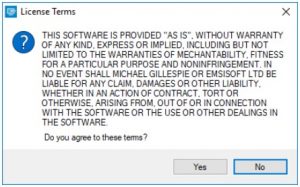
As soon as you accept the license terms, the main decryptor user interface comes up:
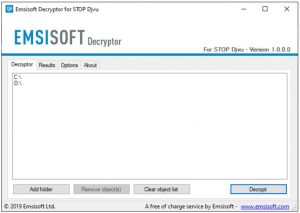
Select folders for decryption.
Based on the default settings, the decryptor will automatically populate the available locations in order to decrypt the currently available drives (the connected ones), including the network drives. Extra (optional) locations can be selected with the help of the “Add” button.
Decryptors normally suggest several options considering the specific malware family. The current possible options are presented in the Options tab and can be activated or deactivated there. You may locate a detailed list of the currently active Options below.
Click on the “Decrypt” button.
As soon as yo add all the desired locations for decryption into the list, click on the “Decrypt” button in order to initiate the decryption procedure.
Note that the main screen may turn you to a status view, letting you know of the active process and the decryption statistics of your data:
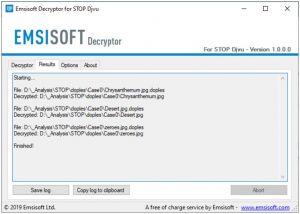
The decryptor will notify you as soon as the decryption procedure is completed. If you need the report for your personal papers, you can save it by choosing the “Save log” button. Note that it is also possible to copy it directly to your clipboard and to paste it into emails or forum messages if you need to do so.
Frequently Asked Questions
How can I open “.lokd” files?
lokd files contain important information. How can I decrypt them urgently?
If not, then you can try to restore them through the system function – Restore Point.
All other methods will require patience.
You have advised using GridinSoft Anti-Malware to remove Lokd. Does this mean that the program will delete my encrypted files?
You need GridinSoft Anti-Malware to remove active system infections. The virus that encrypted your files is most likely still active and periodically,
runs a test for the ability to encrypt even more files. In addition, these viruses install keyloggers and backdoors for further malicious actions
(example theft of passwords, credit cards) often.
Decrytor did not decrypt all my files, or not all of them were decrypted. What should I do?
We will keep you posted on when new Lokd keys, or new decryption programs appear.
What can I do right now?
- In the United States: On Guard Online;
- In Canada: Canadian Anti-Fraud Centre;
- In the United Kingdom: Action Fraud;
- In Australia: SCAMwatch;
- In New Zealand: Consumer Affairs Scams;
- In France: Agence nationale de la sécurité des systèmes d’information;
- In Germany: Bundesamt für Sicherheit in der Informationstechnik;
- In Ireland: An Garda Síochána;
Video Guide
It’s my favorite video tutorial: How to use GridinSoft Anti-Malware and Emsisoft Decryptor for fix ransomware infections.
I need your help to share this article.
It is your turn to help other people. I have written this guide to help people like you. You can use the buttons below to share this on your favorite social media Facebook, Twitter, or Reddit.
If the guide doesn’t help you to remove Lokd virus, please download the GridinSoft Anti-Malware that I recommended. Also, you can always ask me in the comments for getting help.
User Review
( votes)References
- Ransomware-type infection: https://en.wikipedia.org/wiki/Ransomware
- Twitter: https://twitter.com/demonslay335
- My files are encrypted by ransomware, what should I do now?
- About DJVU (STOP) Ransomware.
- GridinSoft Anti-Malware Review from HowToFix site: https://howtofix.guide/gridinsoft-anti-malware/
- More information about GridinSoft products: https://gridinsoft.com/comparison

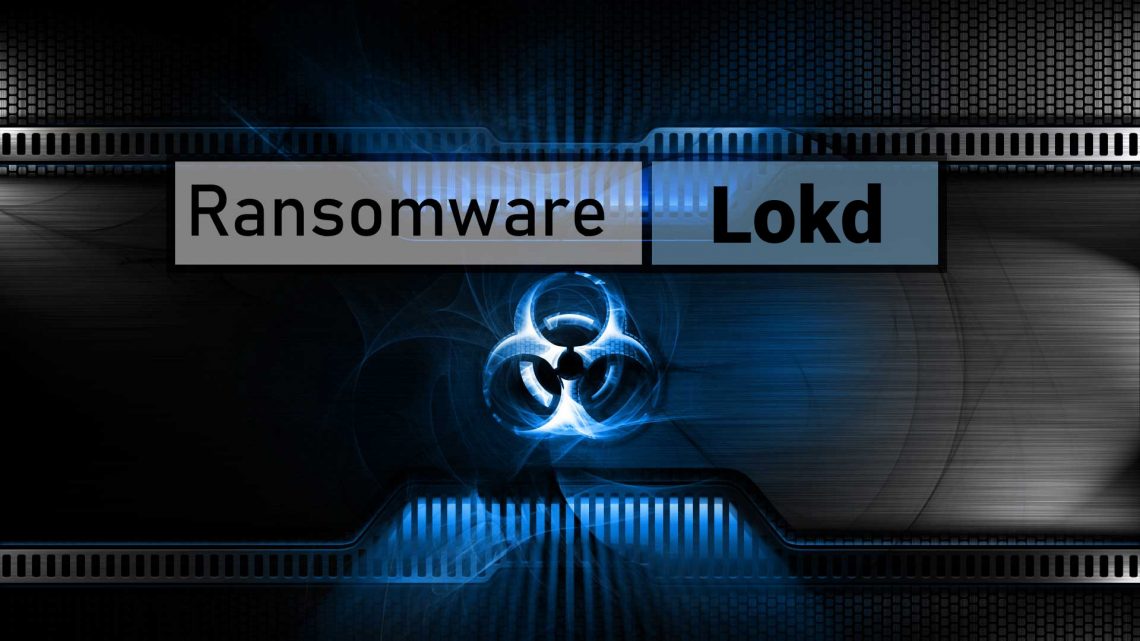

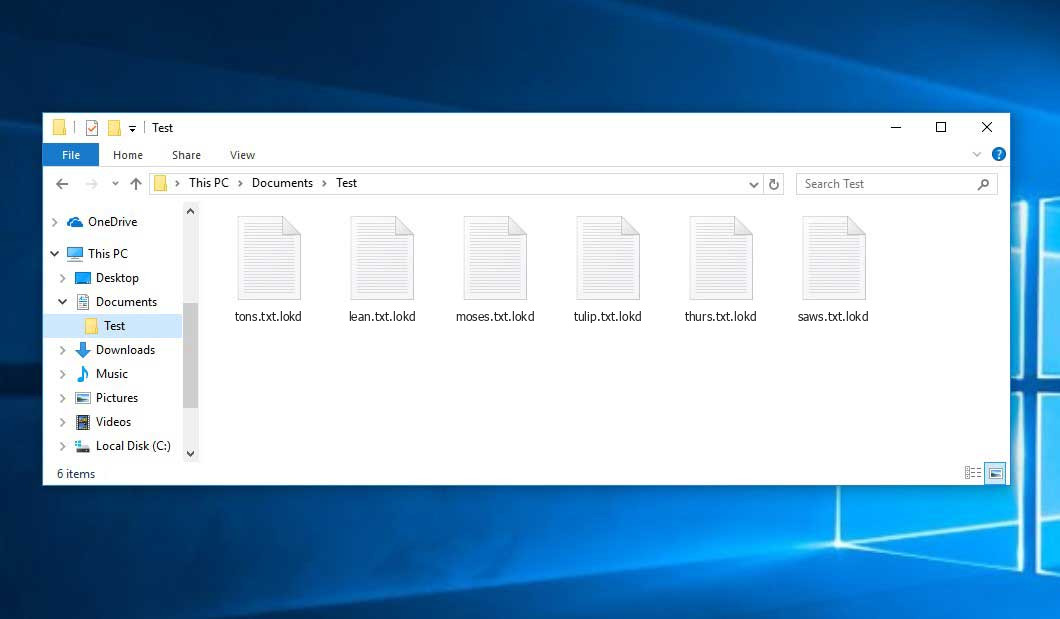
I got infected by .LOKD virus
Please help me to decrypt my files.
.LOKD
PLEASE HELP CALL 7597777787
I got infected by .LOKD virus
Please help me to decrypt my files.
Sir.please help me because my laptop is infected this ransomware virus and I can’t access anything .
Please help me to decrypt all of my computer file !!!😢😭😭
what is the salutation without pay please help me.
decrypt tools :
File: C:\efspp\2 NTFS\LostFiles1\Users\fogep\Desktop\Vadbehívás_000\._02-Szám 2.mp3.lokd
No key for New Variant offline ID: ZHwhSWv4UBPdta8bPx4MWySjbd1cTioHb6WL3Bt1
Notice: this ID appears be an offline ID, decryption MAY be possible in the future